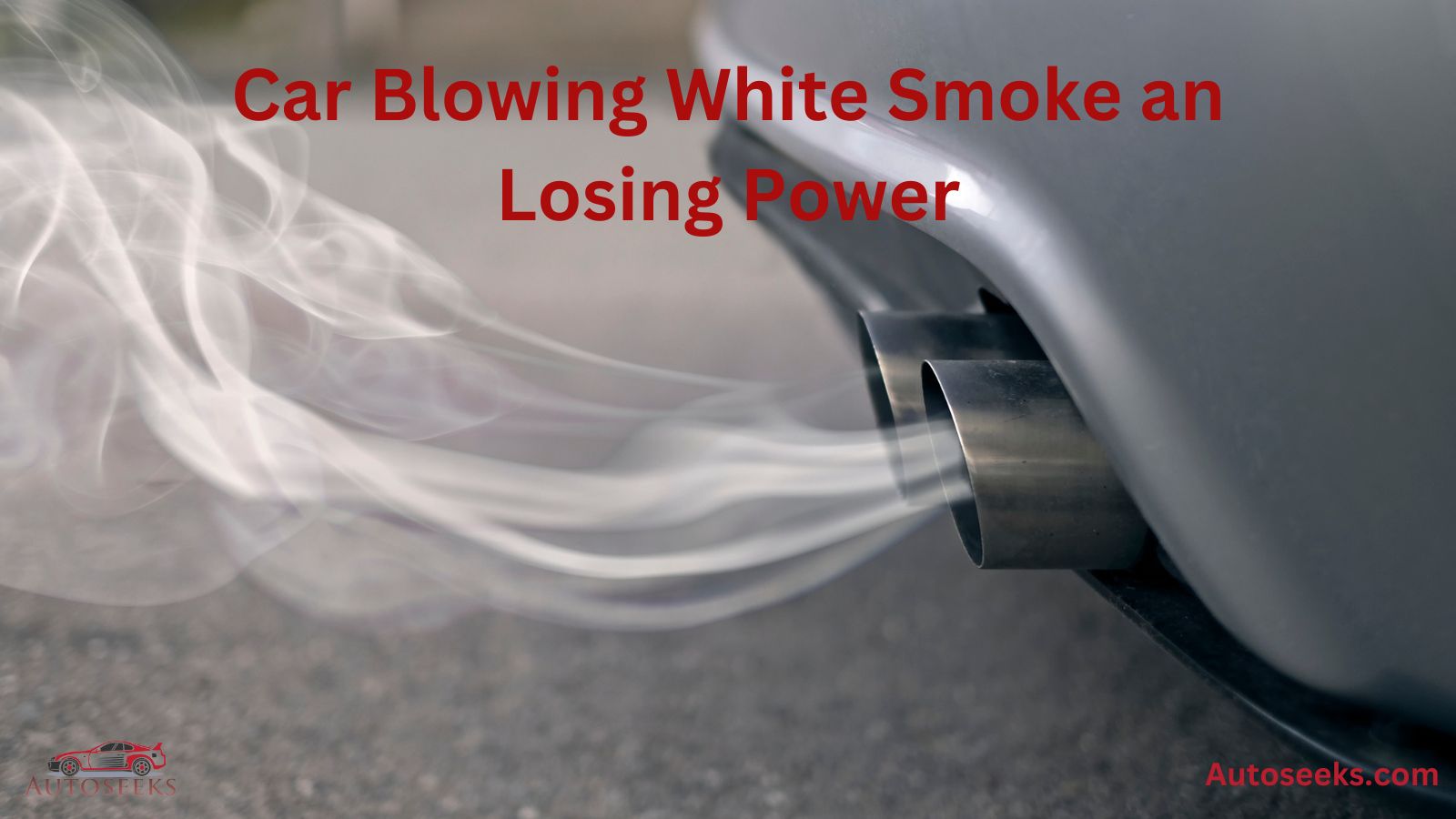White smoke billowing from a car’s exhaust can be an alarming sight for any driver. When accompanied by a loss of power, it becomes even more concerning.
Ignoring these symptoms may lead to further damage and potentially costly repairs. It’s essential to understand the reasons behind this occurrence and take appropriate action to rectify the situation.
In this article, we will delve into the causes behind a car blowing white smoke and experiencing power loss. We will explore the necessary diagnostic steps and potential solutions to address these issues effectively.
Table of Contents
Understanding White Smoke from a Car
White smoke is often an indication of coolant or water vapor entering the engine combustion chamber. The coolant mixes with fuel and burns, resulting in the production of white smoke. The visible smoke may also have a sweet smell, indicating the presence of coolant.
When your car emits white smoke and exhibits a noticeable decrease in power, it indicates an underlying problem that requires immediate attention.
Causes of White Smoke from the Exhaust
White smoke from the exhaust is typically an indication of coolant or water vapor entering the combustion chamber. The presence of coolant mixing with the fuel results in the production of white smoke. It is important to distinguish white smoke from other types of smoke, such as black or blue, as each type may point to different underlying problems.
1. Coolant Leak
One common cause of white smoke is a coolant leak. This leak can occur in several areas, such as a cracked radiator, a damaged hose, or a faulty water pump. When coolant enters the combustion chamber, it burns along with fuel, leading to the production of white smoke.
2. Engine Overheating
Another reason for white smoke is engine overheating. When the engine reaches excessively high temperatures, it can cause coolant to evaporate and mix with the fuel, resulting in white smoke. Overheating can be caused by a malfunctioning cooling system, a faulty thermostat, or a malfunctioning radiator fan.
3. Cracked Cylinder Head or Block

A cracked cylinder head or block can allow coolant to enter the combustion chamber, causing white smoke. These cracks can be the result of overheating, manufacturing defects, or engine stress. It is essential to address these issues promptly to prevent further damage to the engine.
4. Faulty Head Gasket
A faulty head gasket can create a pathway for coolant to leak into the combustion chamber. This leakage leads to white smoke emission. A blown head gasket is often accompanied by other symptoms such as engine misfires, oil contamination, or a milky appearance in the engine oil.
5. Fuel System Issues
Fuel system problems, such as a malfunctioning fuel injector or a faulty fuel pressure regulator, can disrupt the air-fuel mixture. This disruption can cause incomplete combustion and the generation of white smoke. These issues should be addressed to restore proper engine performance.
Diagnostic Steps for White Smoke
After determining the exact cause of white smoke and power loss in your car, it is crucial to perform some diagnostic steps. These steps will help narrow down the underlying problem and guide the necessary repairs.
1. Checking Coolant Levels
Start by checking the coolant levels in the radiator and the coolant reservoir. Insufficient coolant can lead to overheating and subsequent white smoke production.
2. Inspecting the Radiator
Inspect the radiator for any visible leaks, cracks, or damage. A damaged radiator can allow coolant to escape, leading to white smoke and engine overheating.
3. Analyzing the Engine Oil
Check the engine oil for signs of coolant contamination. If the oil appears milky or has a sweet smell, it indicates a possible head gasket failure.
4. Assessing the Spark Plugs

Examine the spark plugs for signs of coolant or oil deposits. An abnormal appearance can point towards internal engine problems.
5. Evaluating the Fuel System
Inspect the fuel system components, such as the fuel injectors and fuel pressure regulator, for any malfunctions. Addressing fuel system issues is essential to prevent incomplete combustion and white smoke.
Solutions for White Smoke and Power Loss
Once you have diagnosed the root cause of white smoke and power loss, appropriate solutions can be implemented to rectify the problem.
1. Repairing Coolant Leaks
If a coolant leak is the culprit, locating and repairing the leak is crucial. This may involve replacing a damaged radiator, fixing a broken hose, or addressing a faulty water pump.
2. Resolving Engine Overheating Issues
To address engine overheating, it is essential to diagnose the cause, such as a malfunctioning cooling fan or a faulty thermostat. Replace or repair the defective components to restore proper engine temperature.
3. Fixing Cylinder Head or Block Problems
If a cracked cylinder head or block is responsible for the white smoke and power loss, professional repairs are necessary. This typically involves removing the cylinder head or replacing the engine block to prevent further damage.
4. Addressing Head Gasket Failures
When a faulty head gasket is the issue, replacing the gasket and conducting a thorough inspection of the engine is necessary. This ensures there are no additional complications caused by the head gasket failure.
5. Dealing with Fuel System Troubles
Repair or replace any malfunctioning components in the fuel system to restore the proper air-fuel mixture. This can involve cleaning or replacing fuel injectors, fixing fuel pressure regulator issues, or ensuring proper fuel flow.
Preventive Measures
To minimize the risk of white smoke and power loss in the future, consider implementing the following preventive measures:
- Regularly inspect and maintain the cooling system, including the radiator, hoses, and water pump.
- Monitor coolant levels and top up as necessary.
- Keep an eye on engine temperature gauges and address any overheating issues promptly.
- Perform regular maintenance on the fuel system, including cleaning or replacing fuel injectors and filters.
- Follow manufacturer-recommended service intervals to ensure the overall health of your vehicle.
FAQs About White Smoke and Power Loss
Can white smoke indicate a minor issue?
While white smoke can sometimes be a result of minor issues such as condensation in the exhaust system, it is essential to investigate further, as it can also indicate more significant problems like coolant leaks or engine issues.
Is it safe to drive a car that blows white smoke?
It is not recommended to drive a car that blows white smoke, especially if it is accompanied by power loss. Continuing to drive in such conditions can cause further damage to the engine.
How much does it cost to fix white smoke and power loss?
The cost of repairs for white smoke and power loss can vary depending on the underlying cause and the extent of the damage. It is best to consult with a qualified mechanic for an accurate assessment and cost estimation.
Can low-quality fuel cause white smoke?
Low-quality fuel can contribute to incomplete combustion, which may result in white smoke. It is advisable to use high-quality fuel from reputable sources to minimize such issues.
Should I continue driving if my car loses power?
If your car experiences a significant loss of power, it is advisable to pull over safely and have the vehicle inspected by a professional. Continuing to drive in such conditions can be unsafe and lead to further damage.
Conclusion
Experiencing white smoke from your car’s exhaust along with a loss of power can be a concerning situation. By understanding the causes, performing diagnostic steps, and implementing appropriate solutions, you can address these problems effectively. Remember to prioritize regular maintenance and preventive measures to avoid future complications.
- Keeping Your Gear Organized and Mobile - May 6, 2024
- Understanding Strut Tower Braces for Your Car - May 3, 2024
- Unlocking The Secrets of Your Car’s Identity with a VIN Decoder - April 25, 2024


